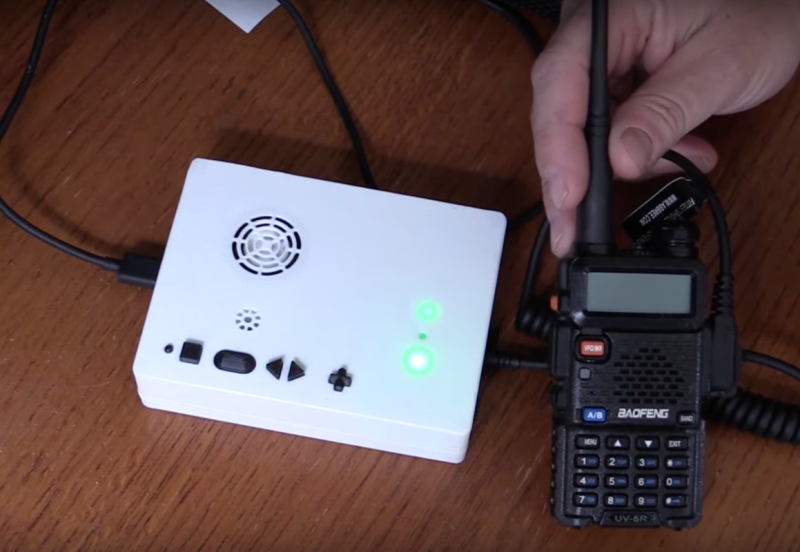For those who grew up with a cell phone in their hand, it might be difficult to imagine a time where the phone wasn’t fully integrated with voicemail. It sounds like a fantastical past, yet at one point a separate machine needed to be attached to the phone to record messages if no one was home to answer. Not only that, but a third device, a cassette tape, was generally needed as a storage device to hold the messages. In many ways we live in a much simpler world now, but in the amateur radio world one group is looking to bring this esoteric technology to the airwaves and [saveitforparts] is demonstrating one as part of a beta test.
The device is called the Boondock Echo, and while at its core it’s an ESP32 there’s a lot going on behind the scenes. It has an audio interface which is capable of connecting to a radio given the correct patch cable; in this case with a simple Baofeng handheld unit. The answering machine can record any sounds that come in. However, with a network connection the recordings are analyzed with an AI which can transcribe what it hears and even listen for specific call signs, then take actions such as sending emails when it hears triggers like that. Boondock also plans for this device to be capable of responding as well, but [saveitforparts] was not able to get this working during this beta test.
While an answering machine might seem like a step backwards technologically, an answering machine like this, especially when paired with Google Voice-like capabilities from an AI, has a lot of promise for ham radio operators. Even during this test, [saveitforparts] lost a radio and a kind stranger keyed it up when it was found, which was recorded by the Boondock Echo and used to eventually recover the radio. Certainly there are plenty of other applications as well, such as using AI instead of something like an Arduino to do Morse decoding.
















It’s worth noting that the Boondock Echo has been covered by HaD before: https://hackaday.com/2023/11/10/hands-on-with-boondock-echo/
why not using MMDVM ham modem?
The Boondock Echo and the MMDVM solve different problems. While there is an overlap of certain functionality — the MMDVM doesn’t record, doesn’t denoise, doesn’t transcribe, doesn’t translate, etc.
My cell still lacks call screening like the old answer machine had.
I need to get one of these and write a different firmware build for it. Couldn’t find them for sale though. I’ve done lots of voice/ai integration with ham radio in recent years.
They’re not for sale yet — but soon! Sign up here for notifications: https://www.crowdsupply.com/boondock-technologies/boondock-echo
If you sign up at http://www.boondockecho.com we can send you a link to the discord and we’d love to talk to you about what you’re doing!
I’d love to know if yall are going to provide a docker container or some other solution(RasPi image?) for self-hosting the back-end?
Unfortunately, I don’t have an answer for that. I do know we have setup instructions. But I don’t know what’s involved in creating a docker container or raspi image. I’d encourage you to ask the questions in our discord (the software developers often respond directly).
Sending prerecorded message in ham radio frequencies is against FCC regulations
Not if your station ID as in for use in a repeater system. Station ID is required every 10 minutes.
Care to cite this? If correct every contest keyer is illegal. And every repeater that when activated spouts off its callsign in CW. Which is all of them. And the amateur satellites too.
A contest keyer has a control op present. Responding automatically to a callsign without a control operator is not legal. Repeaters are a specific case in the rules and permitted automatic operation within certain limits. This is not a repeater and requires a control operator. Citation? Part 97 FCC rules. If you’re a Ham, you should have a copy.
Correct. It would be wise to read Section 97 of the FCC pertaining to amateur radio operations. I also would make sure any radio used has met FCC acceptance and the user has the appropriate license.
It may be valuable to clearly describe the Internet-dependent vs Internet-free features. Also, there are ways to implement some AI-type features, locally, without an Internet connection e.g. Alpaca, Bestee, Hound, & Robin – which would be value-added for emcomm, prepper, and remote location applications.
Boondock Echo a AI-powered answering machine for ham radios. It transcribes ham radio recordings and offering features like message recording, transcription, and lost radio recovery. Wow! This is an amazing time that we are living in. :)